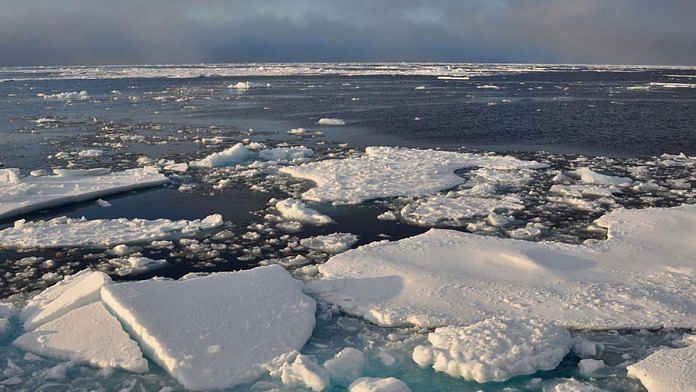New Delhi: The Arctic is heating up at a much faster rate than previously thought, new research has found.
Scientists with the Finnish Meteorological Institute in Finland have found that in recent decades, the Arctic has been warming up four times faster than the rest of the world. They have called the previous estimates of arctic warming “a clear underestimation of the situation.”
Published Thursday in the journal ‘Communications Earth & Environment, the findings show that, between 1979 and 2021, the ratio of warming in the Arctic was four-fold higher than the rest of the world, a phenomenon known as Arctic amplification.
More worrying, the researchers found that the climate models were not accurately capturing the magnitude of Arctic amplification, and likely systemically underestimating its effects. It is popularly thought that the Arctic is warming two times faster than the rest of the world – a refrain challenged by this new research.
“While the magnitude of Arctic amplification is dependent, to some degree, on how the Arctic region is defined, and by the period of time used in the calculation, the climate models were found to underestimate Arctic amplification, almost independent of the definition,” Mika Rantanen, a researcher at the Finnish Meteorological Institute, said in a statement.
The study’s findings are in line with the research published on 11 August that found the Barents sea – north of the Arctic Circle – experiencing maximum surface temperature warming over the last 20 to 40 years.
Last year, the World Meteorological Organization recognised a new record temperature in the Arctic — 38 degrees Celsius — saying it is “more befitting the Mediterranean.”
Also Read: Warm water rushing towards world’s biggest ice sheet—that’s not good news
Observations not uniform
The study’s observations across the Arctic, defined as the Arctic circle, are not uniform.
It found that, between 1979 and 2021, the maximum warming occurred in the Eurasian sector of the Arctic Ocean, near Svalbard (Norway) and Novaya Zemlya (Russia).
In this region, warming occurred “up to seven times as fast as the global average,” the paper says. Warming occurred the most – up to five times faster than the rest of the world – between October and December in the last 43 years.
The research found that even state-of-the-art climate simulation models were not able to capture the observed Arctic amplification.
“We compared the observed Arctic amplification ratio with the ratio simulated by state-of-the-art climate models, and found that the observed four-fold warming ratio over 1979–2021 is an extremely rare occasion in the climate model simulations,” the paper points out.
The researchers say their estimates of Arctic amplification differ from previous estimates because they use updated satellite data, as well as the fact that earlier estimates may be outdated due to continued warming in the Arctic.
“We used the satellite era (1979–2021) when the remote-sensed observations from the Arctic are available and defined the area of the Arctic using the Arctic Circle as the southern boundary (66.5∘–90∘N). With these parameters, the observed rate of warming in the Arctic is 3.8 times as strong as the global average,” says the study.
The researchers are careful to point out that the level of Arctic amplification over the last 43 years is not only because of human-induced climate change but also contributed by natural variations in climate, called internal variability. Internal variability is the changes in climate that have natural and not anthropogenic causes.
To highlight this point, the researchers cited another study, which found that between 40 and 50 per cent of sea ice loss in the Arctic over 37 years may have been caused by internal variability. Sea ice loss is a contributor to Arctic amplification.
They added that if internal variability proves to be a significant source of the difference between the observed Arctic amplification and the model simulations, “one can expect that the observed Arctic amplification will be reduced in the long term.”
(Edited by Siddarth Muralidharan)
Also Read: South Pole warmer by 40°C, North Pole by 30°C. Simultaneous highs alarm scientists



